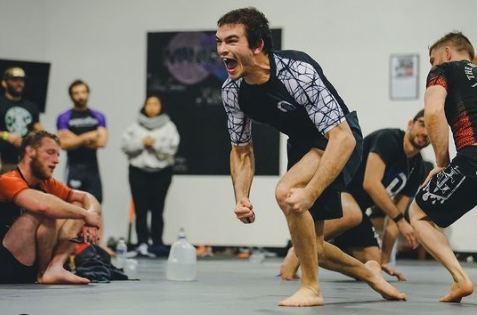As Coronavirus Patients Skew Younger, Tracing Task Seems All But Impossible
Younger people are less likely to be hospitalized or die of COVID-19 than their elders, but they circulate more freely while carrying the disease, and their cases are harder to trace. Together, these facts terrify California hospital officials.
People under 50 make up 73% of those testing positive for the disease in the state since the beginning of June, compared with 52% before April 30. That shift isn’t comforting to Dr. Alan Williamson, chief medical officer of Eisenhower Health in Riverside County’s Coachella Valley.
“It honestly worries me more because it means that this is now established in the community,” he said.
As the virus spreads throughout the United States, figuring out how patients were exposed becomes increasingly difficult, which makes it nearly impossible to stop viral transmission. Younger people with COVID-19 are also less likely to pick up the phone when a contact tracer calls, health officials say. And hospitals are seeing case numbers rise among staffers, who are getting infected in their communities, not necessarily at work.
Los Angeles and nearby counties, whose populations are heavily Latino, have been driving California’s COVID spike and account for a disproportionate number of its cases, as they have since the pandemic’s early days.
The massive wave of new infections has caused deaths among people ages 18 to 40 to slowly mount, from six in the first 10 days of May in Los Angeles County, for example, to 22 in the same period of July.
Hospitalizations have soared among the younger age group, which made up about 10% of people hospitalized in April but account for more than 25% now. Los Angeles County reported Wednesday that 2,193 people were hospitalized with the virus, the highest number since the pandemic started. It gave no detailed age breakdown.
The first wave of patients in March and April at Eisenhower Medical Center, Eisenhower Health’s 463-bed flagship hospital, were mostly nursing home residents and retirees who lived in the area part time. Most were white.
But in June, as the virus spread through the rest of the Coachella Valley — famous for producing dates, citrus and other crops — it also sickened people from the region’s year-round Latino agricultural workforce. While these patients are younger and usually don’t need hospitalization, Williamson has noticed a new trend among those who do.
“Quite frequently, there would be in their history that there are two or three or more other family members that are home and COVID-positive,” he said. “I didn’t see that before.”
In the eastern part of the valley, where multigenerational or multifamily households are common, COVID-positive patients don’t always have the space or resources to live in strict isolation as they recover.
“These are young people living in a household with little kids, teenagers and 70-year-old grandparents,” he said. “That’s not a good formula.”
Most of the younger patients have a benign course of illness. Johnny Luna, 34, who lives in a two-bedroom apartment in the Boyle Heights section near downtown Los Angeles, got tested for COVID-19 in May after experiencing what felt like a mild asthma attack, with shortness of breath and fatigue.
When he received a letter with a positive test result a week later, Luna was dumbfounded. He had no idea where he might have been exposed, since he, his partner and school-age daughter had followed public health recommendations to the letter.
“I washed my hands until they were chapped and dried, and took all the suggested measures,” he said. “In fact, this was the only thing in my entire life that’s gotten me to stop biting my nails.”
As cases mount, contact tracers are having less success getting COVID-positive patients to pick up the phone, said Dr. Jeffrey Gunzenhauser, chief medical officer at the Los Angeles County Department of Public Health. Contact tracers had been able to complete an interview with positive patients more than 70% of the time up until about three weeks ago, he said. Now, the rate is as low as 65%.
“It could be that older individuals who traditionally use phones are more willing to answer phones, whereas younger people might communicate through texting and other means, so maybe they’re less likely to,” he said.
To increase pickups, the department has asked telephone companies to label all calls from contact tracers as “LA Public Health” when they flash on a phone’s display. The department has convened focus groups among young adults to figure out ways to better communicate with them.
In Luna’s case, AltaMed Health Services, which administered his COVID-19 test, said it tried to call him three days in a row and left two voicemails before sending the letter. Luna said that he never received the calls or voicemails — and that the same thing happened to people he knows.
At the beginning of the pandemic, infected patients usually had a good sense of where they were exposed to the virus, and by whom, said Patricia Marquez Sung, an epidemiologist with USC Verdugo Hills Hospital, a 158-bed facility in Glendale, in L.A. County.
People showing up at the Verdugo Hills emergency department with COVID symptoms in June were significantly younger than earlier this year, hospital data shows — and more ER patients say they have “no idea” where they could have contracted the virus, Sung said.
“What that’s telling me is that, potentially, we’re getting a little bit lax with the vigilance in masking, staying home and hand-washing,” Sung said. “People have
gotten restless and their perceptions of risk are a lot lower than three or four months ago.”
Even health care workers are getting restless and venturing out more. Verdugo Hills’ sister hospital, the 401-bed Keck Hospital of USC near downtown L.A., is seeing a rise in health care worker infections from community spread. During the last 10 days of June, 20 staffers tested positive; the hospital’s in-house contact tracing team determined that none of them were exposed to COVID-19 patients at work. In the previous 3½ months the hospital had recorded a total of 68 positives among staff.
Public health officials and political leaders are urging younger people to refrain from parties and large gatherings, and emphasizing the possibility of asymptomatic or pre-symptomatic transmission to more vulnerable populations.
These cautionary messages are especially urgent amid a growing consensus that the virus can linger in the air indoors, said Chris Van Gorder, CEO of Scripps Health, a large nonprofit health system in San Diego County. Previously, leading public health groups like the World Health Organization had said the virus was mostly transmitted directly from person to person, in respiratory droplets that rapidly sink to the ground unless they’re inhaled.
The shift in thinking has painful implications for people — including health care workers — eager to return to indoor restaurant dining and other businesses, said Van Gorder. Some 201 COVID-19 infections were reported among county health care workers in the first week of July, compared with 72 in the last week of May.
Van Gorder learned that some hospital employees went to casinos when they reopened, and another group “decided to go off to dinner together in Little Italy. They know better, and they got sick.”
“I think California was doing a phenomenal job flattening the curve, but there was so much pressure to reopen that we reopened too fast,” he said. “We’re seeing the consequences of that now.”







